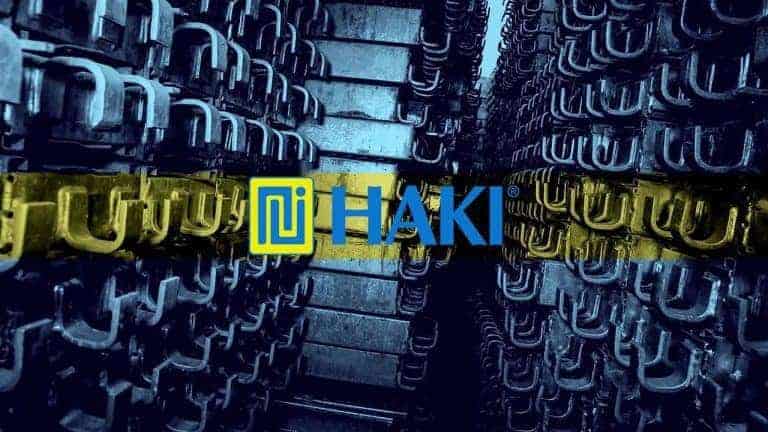First OSTS Scaffolding Supervisor Course Completed in Vietnam
A dozen experienced scaffolders have completed the first CISRS Overseas Scaffolder Training Scheme (OSTS) course delivered in Vietnam.
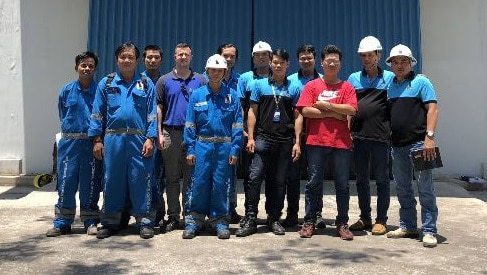 The scaffolders comprised of 11 men and one woman they have worked on sites throughout Asia. They undertook the in-depth and informative training at the AIS / Black Cat JSC Ltd a CISRS-approved training centre in Vang Tau.
Thuyen Cao, Deputy Head of the Scaffold Department at Black Cat JSC Ltd, said: “It is great to see the introduction of an international scaffolding card scheme in Vietnam as this will bring scaffolding to new levels of safety and skills.”
Dave Mosley, CISRS Scheme Manager, added: “It’s excellent that AIS and Black Cat are forging ahead with CISRS OSTS training in Vietnam. They have been training steadily since gaining their accreditation to deliver scaffolding courses, predominantly Level 1 scaffolder and Scaffold Inspection and it is very positive that they have now added the Supervisors course to their programme.
“It is also worthy of note that Ms Chi Le has become their 2nd female scaffold inspector in as many months. Well done to all concerned.”
The scaffolders comprised of 11 men and one woman they have worked on sites throughout Asia. They undertook the in-depth and informative training at the AIS / Black Cat JSC Ltd a CISRS-approved training centre in Vang Tau.
Thuyen Cao, Deputy Head of the Scaffold Department at Black Cat JSC Ltd, said: “It is great to see the introduction of an international scaffolding card scheme in Vietnam as this will bring scaffolding to new levels of safety and skills.”
Dave Mosley, CISRS Scheme Manager, added: “It’s excellent that AIS and Black Cat are forging ahead with CISRS OSTS training in Vietnam. They have been training steadily since gaining their accreditation to deliver scaffolding courses, predominantly Level 1 scaffolder and Scaffold Inspection and it is very positive that they have now added the Supervisors course to their programme.
“It is also worthy of note that Ms Chi Le has become their 2nd female scaffold inspector in as many months. Well done to all concerned.” NASC’S Scaffolding Safety Report reveals on-site accidents fell to record low
The number of accidents and injuries recorded by NASC members fell to an all-time low in 2017, with just 89 incidences occurring on-site throughout the year.
The figure was revealed in the NASC 2018 Safety Report, which documents and analyses accident and injury statistics for its full contracting members – representing more than 16,000 scaffolding operatives across the UK – in the previous calendar year. For the fifth year running, the NASC is able to report a fatality-free year. The number of injuries and accidents in 2017 fell to a new low, continuing a decades-long general trend in ever-reducing incidences. This downward trend corresponds with long-standing efforts to improve health and safety and training in the scaffolding industry, one of the NASC’s core commitments. The NASC Safety Report reveals there were just 17 major injuries recorded in 2017, down 37% from 27 in 2016, and 89 incidences in total, down from 96 in 2016. There was also a 46% reduction in falls from height and 36% reduction in manual handling injuries year-on-year. Additionally, no members of the public were injured around NASC member scaffolds in 2017.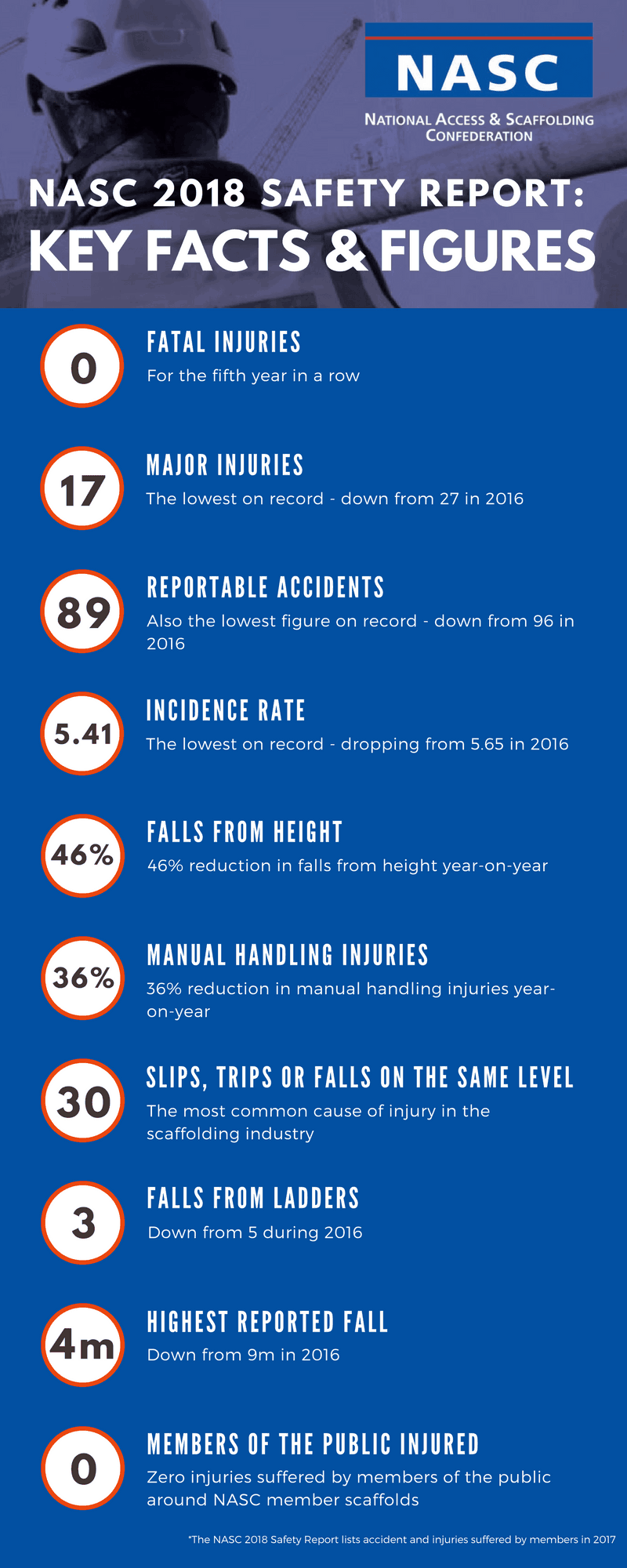 Des Moore, CEO of TRAD Group and NASC President, said: “The 2018 Safety Report shows how workplace accidents can be reduced through compliance with industry safety standards and adherence to NASC guidance.
“It is very encouraging to see that the number of accidents recorded by NASC members fell to a record low in 2017, continuing a long-established downward trend dating back many decades that corresponds with a gradual rise of awareness and implementation of on-site health and safety practices, which continues to this day.
“It is particularly pleasing to look at how far our members have come in just the past five years, with the number of reported incidents having fallen 34 per cent from the 2012 figure (134 to 89) and the incidence and frequency rates both down by more than 40 per cent.
“There is more work to be done, however. For the 13th consecutive year, slips, trips and falls on the same level was the most common cause of accident and injury – representing a third of all reported injuries. This type of incident can easily lead to serious injury or even fatality and as such is something we’ll continue to seek to address.”
Robin James, NASC Managing Director, added: “The NASC is committed to driving up safety standards in access and scaffolding, and firmly believes in the need for accountability and transparency, which is why we go to such lengths to compile and publish the Safety Report each year.
“The data validates our wider efforts to help our members maintain the highest possible standards, enabling them to keep their contracted operatives safe on construction sites across the UK.”
NASC full contracting members are required to submit a detailed accident return as a requirement of membership. The NASC Safety Report is compiled from this data and includes:
Des Moore, CEO of TRAD Group and NASC President, said: “The 2018 Safety Report shows how workplace accidents can be reduced through compliance with industry safety standards and adherence to NASC guidance.
“It is very encouraging to see that the number of accidents recorded by NASC members fell to a record low in 2017, continuing a long-established downward trend dating back many decades that corresponds with a gradual rise of awareness and implementation of on-site health and safety practices, which continues to this day.
“It is particularly pleasing to look at how far our members have come in just the past five years, with the number of reported incidents having fallen 34 per cent from the 2012 figure (134 to 89) and the incidence and frequency rates both down by more than 40 per cent.
“There is more work to be done, however. For the 13th consecutive year, slips, trips and falls on the same level was the most common cause of accident and injury – representing a third of all reported injuries. This type of incident can easily lead to serious injury or even fatality and as such is something we’ll continue to seek to address.”
Robin James, NASC Managing Director, added: “The NASC is committed to driving up safety standards in access and scaffolding, and firmly believes in the need for accountability and transparency, which is why we go to such lengths to compile and publish the Safety Report each year.
“The data validates our wider efforts to help our members maintain the highest possible standards, enabling them to keep their contracted operatives safe on construction sites across the UK.”
NASC full contracting members are required to submit a detailed accident return as a requirement of membership. The NASC Safety Report is compiled from this data and includes:
- Injuries and fatalities to operatives, third parties and members of the public
- Accident types
- Detailed analysis of accidents
Wood partners up to develop wearable camera tech for oil and gas operations
Wood has developed new camera technology that can stream video and store data from remote work locations including offshore, in partnership with Canadian technology company Librestream Technologies (Librestream).
The Onsight Cube is a rugged camera that can be worn on a helmet, chest mount or a mono-pod to access high or difficult-to-reach areas, and connects wirelessly via Bluetooth to a handset. The technology connects specialists in any location directly with remote worksites, transferring real-time data including audio, pictures, thermographic images and video. This allows decision-makers to review current status, issues and collaborate on resolutions which will improve the quality and speed of problem solving, reducing overall job turnaround time and avoiding the unnecessary mobilisation of people to remote locations. Designed with a protective casing to withstand industrial applications, the technology comprises a thermal camera, onboard secure storage and can operate in harsh environments including from -20 to +55°. Dave Stewart, Wood’s CEO of Asset Solutions in Europe, Africa, Asia & Australia said: “Wood and Librestream have established a solid partnership to produce a growing suite of innovative technologies and share a common vision regarding the impact that digital technology can have on safety and productivity in oil and gas operations.
“This product is the result of a successful collaboration combining Wood’s oil and gas expertise with Librestream’s real-time mobile video technology.
“By investing in leading-edge digital solutions for the energy industry and leveraging Librestream’s technology portfolio, we are enhancing our service offering and delivering more efficient solutions to customers from desktop to worksite.”
Kerry Thacher, CEO of Librestream, adds: “The Cube is another example of our commitment to delivering a complete platform for the industrial and mobile worker.
“We recognise that workers in the field require both software and specialised hardware to meet their needs and the Onsight Cube is a significant leap forward in hazardous-location collaboration. This new capability now enables use cases that were previously impossible to implement.”
In 2017, Wood extended its collaborative agreement with Librestream to continue its exclusive industry partnership, providing advanced digitally-enabled solutions for global oil and gas customers.
Dave Stewart, Wood’s CEO of Asset Solutions in Europe, Africa, Asia & Australia said: “Wood and Librestream have established a solid partnership to produce a growing suite of innovative technologies and share a common vision regarding the impact that digital technology can have on safety and productivity in oil and gas operations.
“This product is the result of a successful collaboration combining Wood’s oil and gas expertise with Librestream’s real-time mobile video technology.
“By investing in leading-edge digital solutions for the energy industry and leveraging Librestream’s technology portfolio, we are enhancing our service offering and delivering more efficient solutions to customers from desktop to worksite.”
Kerry Thacher, CEO of Librestream, adds: “The Cube is another example of our commitment to delivering a complete platform for the industrial and mobile worker.
“We recognise that workers in the field require both software and specialised hardware to meet their needs and the Onsight Cube is a significant leap forward in hazardous-location collaboration. This new capability now enables use cases that were previously impossible to implement.”
In 2017, Wood extended its collaborative agreement with Librestream to continue its exclusive industry partnership, providing advanced digitally-enabled solutions for global oil and gas customers.
Layher brings key benefits to refurbishment in Manchester
The benefits arising from the use of Layher Ltd.’s scaffolding during the refurbishment of residential accommodation are being clearly demonstrated in Salford, Manchester, where contractor Silver Star Services has installed a full height scaffold on Albion Towers.
The project, for Salix Homes, has required the scaffolding to reflect specific characteristics of the site while contributing to the smooth running of the overall refurbishment operations being undertaken by Casey Construction. “The work centres on repairs to the external fabric and the replacement of the windows on all four faces of the building at the same time,” says Tony Clarkin, Managing Director of Silver Star Services. “This has called for a scaffold of some 22 two-metre lifts to be installed around the entire structure to enable the specialist teams to gain full access to every part of the building whenever needed.” The installation uses the Layher Allround scaffolding design with steel decking throughout – importantly, with no need for cross–bracing at any point, the unhindered movement of both men and materials is achieved. Hop-up brackets are also featured extensively while the internal faces of each lift also gain from additional toe-boards installed to provide specific protection adjacent to recesses that are a feature of the building’s design. “The wide bay configuration of Layher Allround helps to provide clear access to the building fabric while also optimising the positioning and movement of large components such as window frames,” continues Tony Clarkin. “A passenger and goods lift and a Layher staircase, rising to some 42 metres, both provide continuous access to every level of the scaffold which is tied in to the building at key points and also provides a support for debris netting.” Vitally, the speed with which Layher Allround can be erected helps the project to meet specific time-frame considerations. “We employed just six men to install the full scaffold on all four faces over a six-week period, which we estimate is approximately half the time that would have been needed with a conventional tube and fitting alternative,” adds Tony Clarkin.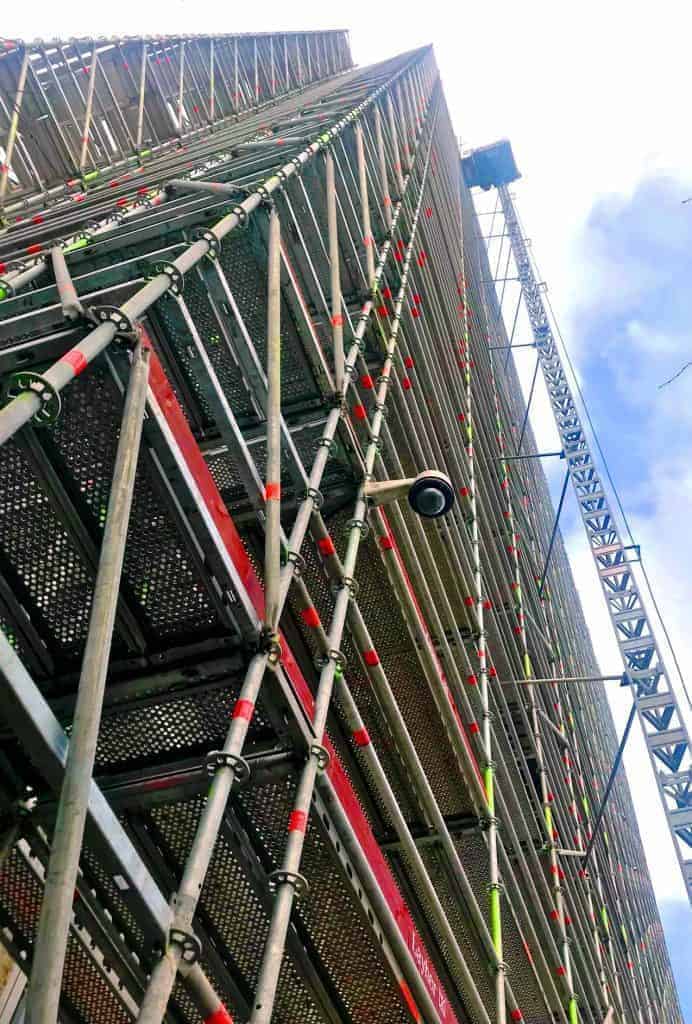 “The comparison is even more significant given the fact that the block is remaining occupied throughout the refurbishment process,” adds Sean Pike, Layher’s UK Managing Director. “The noise disruption, time-frame and potential loss of daylight could all have been significant factors for the residents if tube and fittings had been used.” The design of Layher Allround, which is centred on a series of standard components with a versatile, in-built rosette connection system that contributes directly to optimising safety, has also helped Silver Star Services to enhance the appearance of the installation.
With the project scheduled for 36 weeks, this is of particular importance in a residential location. “Our widespread use of Layher equipment brings advantages, such as those seen at Albion Towers, to every project,” concludes Tony Clarkin, “which, coupled with the design and support input from the company, helps us to maximise the quality and safety of our work each time. The Albion Towers installation in Salford is a prime example of these factors in practice.”
“The comparison is even more significant given the fact that the block is remaining occupied throughout the refurbishment process,” adds Sean Pike, Layher’s UK Managing Director. “The noise disruption, time-frame and potential loss of daylight could all have been significant factors for the residents if tube and fittings had been used.” The design of Layher Allround, which is centred on a series of standard components with a versatile, in-built rosette connection system that contributes directly to optimising safety, has also helped Silver Star Services to enhance the appearance of the installation.
With the project scheduled for 36 weeks, this is of particular importance in a residential location. “Our widespread use of Layher equipment brings advantages, such as those seen at Albion Towers, to every project,” concludes Tony Clarkin, “which, coupled with the design and support input from the company, helps us to maximise the quality and safety of our work each time. The Albion Towers installation in Salford is a prime example of these factors in practice.” SGB – Building It Back Up
After a tumultuous few years, legendary scaffolding and access company SGB are well and truly back in business as part of the BrandSafway group. We spoke to Kevin Fitzpatrick, head of commercial and mechanical businesses for the UK, about the company’s decision to return to their original name and the prospects for the future.


The rise and fall of the SGB brand might not quite be as dramatic as a phoenix rising from the ashes, but the narrative is far from being one of a dog returning home with its tail between its legs.Kevin’s own journey in the business owes a lot to family; it was his uncle, the one-time head of SGB, who gave him a break into the industry some 35 years ago. That said, Kevin did have to do his fair share of grafting to make it to where he is today, taking further education courses in engineering and management, not to mention sticking with the company through thick and thin. Given the company’s legendary reputation and its recent, albeit brief, disappearance from the market, it is easy to imagine the SGB story as that of the phoenix rising from the ashes. Kevin doesn’t see it that way, however. When probed about the company’s troubles after the initial rebrand, he responds: “I would not call this ‘trouble’ to be honest. It is a natural thing that any rebranding process takes time and effort.” Admitting “the change in the business name did set some confusion in the market about who we were,” Kevin says that the company was able to keep a steady ship thanks to hard-work, dedication and “still providing the excellent service and safety performance” so strongly associated with the SGB brand.
 It just goes to show that you can easily change a company’s brand identity, but it is not so easy to change the ethos and lifeblood of the company. So, the fall and rise of the SGB brand might not be quite as dramatic as a phoenix rising from the ashes, but the narrative is far from being one of a dog returning home with its tail between its legs.
Indeed, going back to the original branding could suggest that, ultimately, a mistake was made to drop the SGB name in the first place. But these things are always part and parcel of the process when new ownership comes in and it is often out of the hands of people like Kevin who have dedicated their life to making their company and brand a success. If nothing else, there is a lesson to learn here for the larger corporations of the scaffolding and access industry: there is no substitute for the power of brand identity, especially one with a history as impressive as SGB’s. Now there is plenty of business prospects for SGB going forward.
As Kevin tell us, the reversion to the SGB name “has led to very positive customer feedback and has given us a lot of tailwind” and that “being part of the BrandSafway group helps us to grow our product and service portfolio further.”
This article was first published in the Spring 2018 issue of the ScaffMag magazine.
It just goes to show that you can easily change a company’s brand identity, but it is not so easy to change the ethos and lifeblood of the company. So, the fall and rise of the SGB brand might not be quite as dramatic as a phoenix rising from the ashes, but the narrative is far from being one of a dog returning home with its tail between its legs.
Indeed, going back to the original branding could suggest that, ultimately, a mistake was made to drop the SGB name in the first place. But these things are always part and parcel of the process when new ownership comes in and it is often out of the hands of people like Kevin who have dedicated their life to making their company and brand a success. If nothing else, there is a lesson to learn here for the larger corporations of the scaffolding and access industry: there is no substitute for the power of brand identity, especially one with a history as impressive as SGB’s. Now there is plenty of business prospects for SGB going forward.
As Kevin tell us, the reversion to the SGB name “has led to very positive customer feedback and has given us a lot of tailwind” and that “being part of the BrandSafway group helps us to grow our product and service portfolio further.”
This article was first published in the Spring 2018 issue of the ScaffMag magazine. 50 Years Of Success – Lyndon Scaffolding CEO Rob Lynch Interview
Being the best scaffolding company they can possibly be is what continues to drive on one of the UK’s top family firms – now into its 50th profitable year. No job is too big for Lyndon Scaffolding as it celebrates half a century of success. Grahame Anderson caught up with CEO Robert Lynch to discover the secret behind its outstanding reputation.
Projects don’t come much bigger or more prestigious than the Scottish Parliament Building, Welsh Assembly and BBC Broadcasting House. But I wondered if there was a project Lynch was particularly proud of? Rob explained: “Of the more recent really large-scale projects, Birmingham Gateway – New Street station, is one I am very proud of, a hugely complex project with rail and public interface spread out over four years. The project for Network Rail has transformed the centre of our home town. “But if I had to pick one project in the last few months highlighting what we are trying to achieve, it would be a complex drop lift scaffold on a city centre site. Although the job wasn’t very great in value, it certainly showcased a high level of expertise in traditional scaffolding, and our design capacity. More than anything else however, what really stood out was the fact the charge-hand scaffolder stopped the job… “Prior to erecting one section of the scaffold the team became uncomfortable with the exclusion zone, and despite protestations from the client’s site management, they refused to start work until a larger exclusion zone and out of hours working meant our team was happy. “This is exactly what I want from a team of scaffolders. I want them to have confidence in their assessment as professionals, to be prepared to stop the job when they have safety concerns, and to know that they will be supported by regional management, and me. I want our scaffolders to recognise when it comes to erecting scaffolding they are professionals and to have the confidence to act accordingly.”

We believe by spreading the message we can encourage our scaffolders to recognise how amazing the structures are they erect, take greater pride in what they achieve and be given the respect they deserve.“But we aren’t just a body shop providing interchangeable labour. We want to train and develop our employees for the long term. The development takes a long time as formalised training courses are only part of it. Our commitment to quality is more than just sticking someone on a course, we need to prove to our employees we really mean it, and when they need to make a difficult call and stop a job we will support them. Scaffolders need to provide the desire to be the best scaffolder they can be. Lyndon Scaffolding has made a profit in every one of its 50 years, and just as importantly reinvested those profits into the business.”
 Lyndon is continually striving to enhance innovations within the industry, and their new award-winning site inspection app is certainly proof of that as Rob explained:
“The objective was simple; to improve the quality of the inspections we undertake, and by doing this making the scaffolds safer for the user. We have invested a massive amount of time and money in developing a programme which helps the scaffold inspector do his job better. It makes it easier to report faults and provides clear and concise information to our team and our clients.
“In terms of other ideas, we have a few ideas aimed at trying to get our workforce more involved in the business. I believe we can use social media such as Facebook more effectively, and we have already introduced a popular photography competition. Next, we will be launching an innovations competition offering very significant cash prizes.
We believe by spreading the message we can encourage our scaffolders to recognise how amazing the structures are they erect, take greater pride in what they achieve and be given the respect they deserve.
“During 2017, we purchased Taylor’s Hoists, (a premium Alimak only contract hoist business) in response to a growing demand from customers to offer an integrated hoist and scaffold ‘Total Access’ package, which is an exciting additional service.”
The life of any CEO is without question generally a busy one, so I wondered how this inspiring company leader saw his job?
“My role is primarily about setting the overall course, agreeing the long-term goal and then making sure that we all do what is necessary to get there. It’s really easy to lose the long-term vision, and to get caught up in daily issues. My job is to remind us all of what we are trying to achieve over the next 10 years. and beyond.
“Lyndons has a fantastic legacy of expertise, financial resources and respect. As a result of this, unlike some other businesses we don’t live or die by achieving short term budgets and targets. I am in the privileged position of taking the long view.”
2018 is a landmark 50th year for this extra-ordinary business leading the way in so many aspects of the industry. So what plans do they have for celebrating half a century of superb service? Rob said:
“This might seem perverse, but I took quite a bit of persuading before I was convinced that we should mark our 50th anniversary in any way at all. This isn’t because I am grumpy, but the fact I didn’t want anyone to think it was a sign of complacency – a view ‘now we have made it!’ We haven’t got there yet; there are so many areas we want to improve on and a number of innovations I am really excited about.
But a 50th anniversary was too good an opportunity to miss, so we will be holding a dinner in Birmingham where we will take a moment to thank everyone who has helped us get to 50 years, and will help us carry on trying to be the best scaffold company we can possibly be.”
Happy Birthday Lyndon Scaffolding!
This article was first published in the Spring 2018 issue of the ScaffMag magazine. View Issue
Lyndon is continually striving to enhance innovations within the industry, and their new award-winning site inspection app is certainly proof of that as Rob explained:
“The objective was simple; to improve the quality of the inspections we undertake, and by doing this making the scaffolds safer for the user. We have invested a massive amount of time and money in developing a programme which helps the scaffold inspector do his job better. It makes it easier to report faults and provides clear and concise information to our team and our clients.
“In terms of other ideas, we have a few ideas aimed at trying to get our workforce more involved in the business. I believe we can use social media such as Facebook more effectively, and we have already introduced a popular photography competition. Next, we will be launching an innovations competition offering very significant cash prizes.
We believe by spreading the message we can encourage our scaffolders to recognise how amazing the structures are they erect, take greater pride in what they achieve and be given the respect they deserve.
“During 2017, we purchased Taylor’s Hoists, (a premium Alimak only contract hoist business) in response to a growing demand from customers to offer an integrated hoist and scaffold ‘Total Access’ package, which is an exciting additional service.”
The life of any CEO is without question generally a busy one, so I wondered how this inspiring company leader saw his job?
“My role is primarily about setting the overall course, agreeing the long-term goal and then making sure that we all do what is necessary to get there. It’s really easy to lose the long-term vision, and to get caught up in daily issues. My job is to remind us all of what we are trying to achieve over the next 10 years. and beyond.
“Lyndons has a fantastic legacy of expertise, financial resources and respect. As a result of this, unlike some other businesses we don’t live or die by achieving short term budgets and targets. I am in the privileged position of taking the long view.”
2018 is a landmark 50th year for this extra-ordinary business leading the way in so many aspects of the industry. So what plans do they have for celebrating half a century of superb service? Rob said:
“This might seem perverse, but I took quite a bit of persuading before I was convinced that we should mark our 50th anniversary in any way at all. This isn’t because I am grumpy, but the fact I didn’t want anyone to think it was a sign of complacency – a view ‘now we have made it!’ We haven’t got there yet; there are so many areas we want to improve on and a number of innovations I am really excited about.
But a 50th anniversary was too good an opportunity to miss, so we will be holding a dinner in Birmingham where we will take a moment to thank everyone who has helped us get to 50 years, and will help us carry on trying to be the best scaffold company we can possibly be.”
Happy Birthday Lyndon Scaffolding!
This article was first published in the Spring 2018 issue of the ScaffMag magazine. View Issue Snake bite kills Scaffolder
 A 46-year-old scaffolder has been killed by an eastern brown snake in Queensland, Australia.
A 46-year-old scaffolder has been killed by an eastern brown snake in Queensland, Australia.
Mr Aaron Bryant died after a 1.5m long juvenile eastern brown snake bit him on Thursday evening, as he tried to remove the snake from his property, fearing for the safety of his family and pets.
Despite the CPR efforts of his partner, a neighbour and paramedics who worked on him for about 20 minutes, Mr Bryant could not be revived.
The Eastern Brown is the second most toxic land snake in the world and accounts for more fatalities than any other snake deaths in Australia.
It can be found across most of eastern Australia, commonly found in open grasslands, pastures and woodland. 430 people evacuated from Hong Kong hospital after scaffolding catches fire
Investigations are underway to determine the cause of a blaze on a bamboo scaffold surrounding a hospital in Hong Kong.
More than 400 people had to be evacuated from Yan Chai Hospital Multi-services Complex in Hong Kong. The hospital houses an elderly care center, nursery, rehabilitation centre and other facilities. Local fire crews were called when flames broke out on part of the bamboo scaffolding outside the second and third floor of the building. A water jet was used to battle the blaze and flames were extinguished within 30 minutes. Local authorities say no injuries were reported. Although a fire risk in itself, Bamboo scaffolding is still widely used in major construction projects in Hong Kong.New HAKI.com website goes live
Global scaffolding manufacturer HAKI unveil a brand new website HAKI.com
The multi-language website launched yesterday (April 17th) replacing the old websites, which featured separate HAKI domains in different languages for different markets within the HAKI sales network. Now these are all housed under one user friendly .com site, with translations into English, French, Danish, Norwegian and Swedish easily available from a menu on the website’s header.
Featuring advanced functionality and fully optimised for an enhanced user experience regardless of the choice of desktop, mobile or tablet viewing device, HAKI.com showcases the growth of the HAKI brand, its proud 60+ year heritage, the latest business news, fascinating project reports from across the globe and a plethora of product information.

Brand new system scaffolding products like the HAKI Bridge System (HBS), Public Access Staircase (PAS), UTV slim stair tower and the MK2 of the brand’s world-famous HAKI Stair Tower system take pride of place in the products section of the website.
And the busy HAKI #Gethooked social media streams and films are integrated into a central ‘social hub’ on the home page – allowing HAKI clients, new and old, to stay up to speed with the many developments within the global Swedish brand in one place.
The all-new website also features a packed downloads section – offering a wealth of useful user material, technical data and product information for HAKI clients and prospective buyers alike. And there is a simple to operate contact section, allowing users to locate the HAKI sales, training and technical/product support networks nearest them.
Chris Stokes, VP Marketing and Business Development for HAKI said: “Developed across the HAKI network and marketing team, the website has been over a year in construction and offers the very latest in website design and we’re thrilled to be able to unveil the new site. It’s a superb ‘shop window’ into the expanding HAKI product range and worldwide brand.
“We are confident the new site will be a great asset for the business and to the HAKI brand, as well as receiving wide use across our global sales network as a useful, modern sales tool. Most of all, we are sure it will help people understand why HAKI Scaffolding, weather protection and stair tower systems are the safest, fastest and most productive and adaptable choice for all their access needs, whatever and wherever the job.”
The HAKI website can be viewed now at www.HAKI.com.

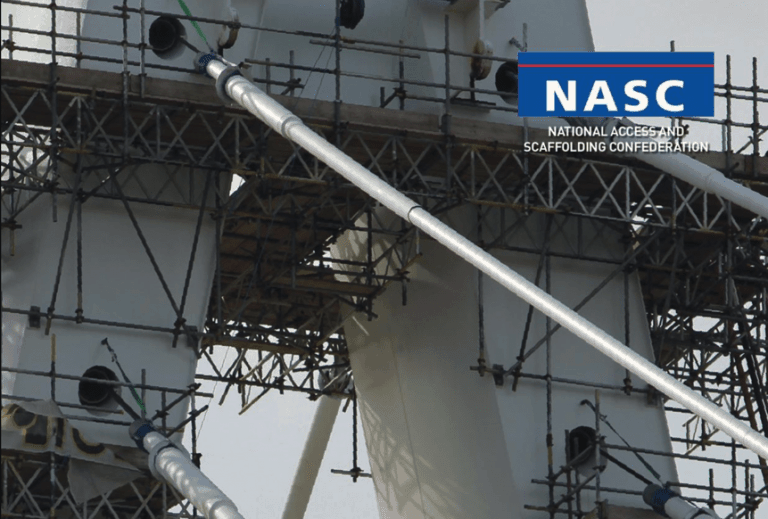





 A 46-year-old scaffolder has been killed by an eastern brown snake in Queensland, Australia.
A 46-year-old scaffolder has been killed by an eastern brown snake in Queensland, Australia.
